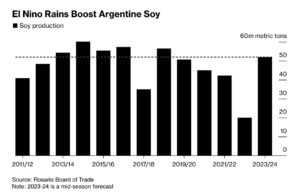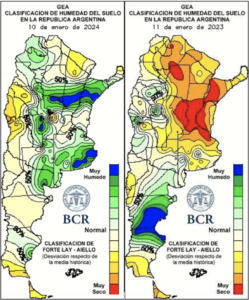China will suspend retaliatory tariffs on U.S. imports, including duties on farm goods, after last week's meeting of the two countries' leaders, Beijing confirmed on Wednesday, but imports of U.S…
Argentina’s Rosario Exchange increases soybean and corn production estimates
Bloomberg reporter Jonathan Gilbert reported yesterday that “Argentina is on course to produce its best soybean crop in five seasons — 52 million metric tons — as El Nino-fueled rains water fields that were parched by several years of drought.”
“An Argentine soy harvest of 52 million tons would surpass last year’s miserly crop by 160%, impacting not only benchmark futures trading in Chicago but also the chances that new President Javier Milei can turn around the country’s economy,” Gilbert wrote. “That’s because shipments of the oilseed normally account for roughly a quarter of all the country’s export revenues.”
Last year, Argentina’s soy crop was just 20 million metric tons, according to Bloomberg, and has not been over 50 million metric tons since the 2019/20 season.

The increase in soy production in Argentina is already having an impact on oilseed markets, according to reporting from Reuters, which said yesterday that “Chicago soybean futures regained some ground on Thursday but remained near their lowest since December 2021 amid lacklustre demand for U.S. exports and an improved South American supply outlook.”
“Recent rains mean Brazil’s harvest will be better than previously feared while Argentina’s will also be sizeable, said Rabobank analyst Vitor Pistoia, adding that the wider oilseed market was well supplied,” Reuters said. “The price outlook for soybeans was ‘neutral or bearish’, Pistoia said.”
Things could change with the grain markets today, however, when the United States Department of Agriculture releases its World Agricultural Supply and Demand Estimates report, according to Reuters.
The primary reason for the increase in Argentine soybean production, according to a translated report from the Rosario Grains Exchange, is rain in the western growing regions of the country.
The Exchange reported that just one month ago, many areas — “west of the Pampas region, La Pampa, and, above all, SW of Buenos Aires, a large part of Córdoba” — all had soils in the red, meaning they needed between 4 and 6 inches of rain “to return to optimal conditions.”

Over the last month, however, “the change has been noticeable in much of the west throughout Argentina,” the Exchange’s Cristian Russo wrote. “Surveys indicate that prime soybeans are in good to excellent condition and that, if this continues, high yield potential is expected. Second-class soybeans have some problems, since they have been planted outside of optimal dates, but they still have time to recover.”
While the Rosario Grains Exchange predicts a significant crop, other organizations are predicting slightly smaller crops, including Post, which is maintaining “production estimated at 50.5 MMT in MY2023/2024,” according to a report from the USDA Foreign Agricultural Service’s Chase McGrath.
McGrath also references recent rains in the country as improving conditions in major growing areas of the country.
“In conversations with local industry contacts optimism shines through with expectations for more normal precipitation throughout the growing season,” McGrath wrote. “Some industry analysts expect an even larger harvest of as much as 53 MMT this year.”
In addition to increased soybean production, the Rosario Grains Exchange also upped its corn production forecast to 59 million metric tons, which would be a record crop for the country.
“This production would be a milestone to the extent that it would exceed by 7.5 MMT the highest registered marks, those of the 2018/19 and 2019/20 campaigns (both with 51.5 MMT),” Russo wrote.
Russo wrote that, like soybeans, corn has benefited from recent rains in major growing areas of the country.
“A year ago, the lots of early corn were lost; Now, however, they have had an excellent passage through their most critical period and have good moisture reserves,” Russo wrote.





